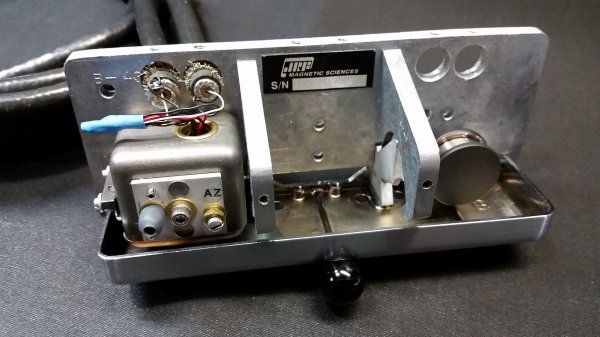Here's an Ampex 350 head assembly I had JRF Magnetics modify a few years back. It started as one of those play-only units where a dummy idler was factory-installed in position 1 and a PB head in position 3. John reversed the orientation, putting the PB head first, machined the center to accept a 440-type scrape-flutter idler (not installed in this photo) and moved the dummy head to the last position. The static guides on the transport idler roller and takeup tension arm were also replaced with hand-picked ABEC-7 bearings.
The idea was to have the tape pass over the playback head first before encountering any static guides that would introduce additional flutter.
It was a good idea but I wasn't able to prove that the net results were better than the standard head configuration. A few people thought the playback was characteristically 'different' between the two setups but we couldn't agree if the concept worked as intended.
Swapping between this unit and a stock assembly took time, perhaps a half-hour to do the swap and do a quick alignment/azimuth check. And, the head in this unit is a Flux Std replacement unit, not Ampex. Since we were listening to older recordings in which some scrape flutter was already present (that we previously identified), we would continue to hear that artifact but weren't able to distinguish if the modified unit didn't add additional S/F on playback. The ability to record new material onto new tape probably would have been a better test but obviously we weren't set up to do that (the machine was built as a repro-only).
Tom
The idea was to have the tape pass over the playback head first before encountering any static guides that would introduce additional flutter.
It was a good idea but I wasn't able to prove that the net results were better than the standard head configuration. A few people thought the playback was characteristically 'different' between the two setups but we couldn't agree if the concept worked as intended.
Swapping between this unit and a stock assembly took time, perhaps a half-hour to do the swap and do a quick alignment/azimuth check. And, the head in this unit is a Flux Std replacement unit, not Ampex. Since we were listening to older recordings in which some scrape flutter was already present (that we previously identified), we would continue to hear that artifact but weren't able to distinguish if the modified unit didn't add additional S/F on playback. The ability to record new material onto new tape probably would have been a better test but obviously we weren't set up to do that (the machine was built as a repro-only).
Tom


